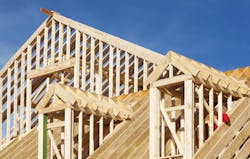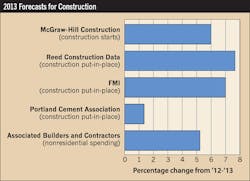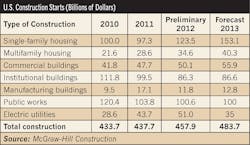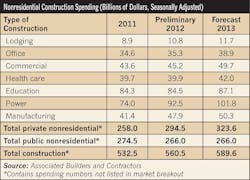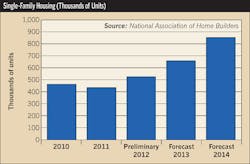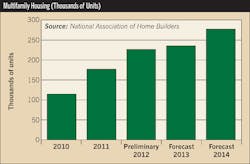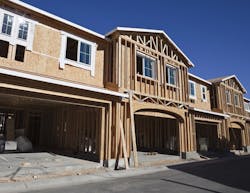In 2012, the U.S. economy managed to avoid entering another recession, despite estimates toward the end of the year that put the risk at around 40%. While McGraw-Hill Construction offered two forecasts for last year — 0% change for U.S. construction starts under regular conditions and a 7% decrease should the economy have shrunk into a recession again — actual construction starts outperformed expectations with a 5% increase. Projections for increases in total construction put-in-place ranged from 0.9% by Portland Cement Association to 6% by FMI Corp. Revised forecasts for gains in total construction put-in-place for 2012 now range from 5.0% to 5.9%.
If the fiscal cliff is allowed to be reached, according to a recent report released by the Congressional Budget Office, the effects include 9.1% unemployment and a 0.5% decline in GDP. The spending cuts could result in a 9.4% decrease in military construction and an 8.2% drop in non-defense sectors, such as water infrastructure.
“The election theoretically should have solved some of this by making it clear where we stand so the politicians can work this out,” said Bernard Markstein, chief economist for Reed Construction Data, during the webcast “Post-Election: Where Is Construction Headed?” sponsored by his organization, the Associated General Contractors of America (AGC), and the American Institute of Architects (AIA). “But I’m already hearing rhetoric that makes me a little nervous.”
Yet, Markstein feels confident there will be a resolution before the fiscal cliff is reached. “What’s going to happen is there’s going to be an extension of current law, probably for about three or four months, while they work out the problem,” he says. “We’re not going to fall off that fiscal cliff. They will deal with it as they always have. The sad part is that they always wait until the last minute.”
Hanging tough
AIA estimates that the sequestration targets would produce about a $2 billion a year decline in federal building construction. “It’s not a major piece but certainly significant enough to be felt in terms of a decline in construction activity,” says Kermit Baker, chief economist for AIA and senior research fellow at the Joint Center for Housing Studies, Harvard University, who also believes there will be a resolution, though postponed. “There’s optimism that a compromise will be coming, but certainly not until the eleventh hour,” he concludes.
“It seems likely the stalemate that has gripped Congress ever since it passed the Budget Control Act, with its Draconian threat of massive cuts in spending and the prospect of expiring tax breaks, we are ever getting closer to that cliff,” says Ken Simonson, chief economist for AGC, during the joint webcast. “We won’t know whether we’re going over the cliff and then perhaps climbing our way back up with some kind of grand compromise right after the taxes jump up, or if we’re actually going to see an extended period of tax increases and spending cuts. We’re not going to know that before New Year’s Eve. That’s very worrisome. It’s going to have a negative effect on stock markets and on investment decisions by companies right through the end of December and perhaps much longer.”
Thus, the biggest threat from the fiscal cliff is the current atmosphere of uncertainty it has created. “The risk of no immediate resolution, and going over the fiscal cliff for several weeks to a month or two, remains,” Markstein continues. “At best, it looks like nothing will be done until near the end of December, disquieting the financial markets and adding unneeded uncertainty to business planning.”
This level of uncertainty is greater than we’ve ever seen, said Robert Murray, VP, economic affairs, for McGraw-Hill Construction, addressing the attendees at the McGraw-Hill 2013 Outlook Executive Conference in October. “We’re engaged in a situation of muddling along,” he said.
In late February or early March, the U.S. Treasury is expected to hit its debt ceiling — the temporary solution for the previous round of debate over this issue is the cause of the current fiscal cliff. Failure to raise the ceiling would prevent the U.S. government from borrowing to meet its existing legal obligations, including the issuance of monthly Social Security checks.
Furthermore, uncertainty over new government regulations, particularly the pending Dodd–Frank Wall Street Reform and Consumer Protection Act, has caused concern for financial institutions, which makes them hesitant to lend. Again, Markstein believes the government will resolve this issue before the deadline. “They will have to deal with it,” he says. “I don’t think the government will shut down.”
Overall, the forecasts for 2013 are optimistic (Fig. 1 above). Assuming these issues are resolved, the Reed Construction Data forecast predicts total construction spending to increase 8.3% in 2012, 7.7% in 2013, and 9.2% in 2014 (Table 1). McGraw-Hill Construction expects an increase of 6% in 2013 (Table 2 below).
FMI Corp., Inc. is predicting an 7% hike for 2013 (Table 3). “Overall, we expect to see continued slow growth and recovery and ongoing change within the industry via technology, consolidation, and the search to find viable new sources of funding for the increasing backlog of postponed projects and damaged infrastructure that so urgently needs attention,” reads the firm’s 2013 U.S. Markets Construction Overview report.
However, remaining cautious, the Portland Cement Association (PCA) is forecasting a mere 1.2% increase (Table 4). “Because we believe the odds for either outcome are even, we have adopted a forecasting approach that minimizes up and downside risk,” said Ed Sullivan, chief economist for PCA, in a press release accompanying the organization’s forecast. The longer Congress delays in addressing the fiscal cliff, according to Sullivan, the greater the adverse effect on economic growth and construction activity in particular. “If no action is taken by mid-2013, the country could be headed into a severe recession,” he warns.
Associated Builders and Contractors(ABC) is predicting nonresidential construction spending to expand 5.2% (Table 5). However, its estimates for GDP expansion or contraction depend largely on reaching budget and debt ceiling agreements. In a press release accompanying the organization’s forecast, Anirban Basu, chief economist for ABC, is expecting GDP growth for 2013 to reach between 1% to 2%, unless the nation falls off its fiscal cliff, which Basu would expect to cause GDP to fall between 2% to 3%. “The U.S. economy is presently expanding at a 2% rate,” said Basu. “Even in the absence of a dive off the federal precipice, the nation will struggle to achieve 2% growth next year, as certain tax rates rise and as federal spending growth slows and perhaps turns sharply negative.”
Residential comeback
Industry experts are basing their forecasts on strong numbers from the housing market. “Housing looks like it’s finally stabilized,” said Beth Ann Bovino, deputy chief economist, Standard & Poor’s, speaking at the McGraw-Hill 2013 Outlook Executive Conference. “With each year, it continues to heal,” she said, putting the risk of falling into another recession in 2013 between 20% to 25%. “This year will be the first year housing will contribute to GDP growth since 2005.”
According to Bovino, the new home supply, currently at four and a half months, is at a record low. “We have been cleaning up the inventory of unsold homes,” says Bovino, who estimates the shadow inventory at 2 million — or around a five-month supply. “This gives support to price increases as we go along.”
Mark Zandi, chief economist for Moody’s Analytics, has used the strong housing market as the foundation for a confident estimate for GDP and job growth. He is predicting GDP to settle in the 2% range this year and next and to double — closer to 4% — in 2014 and 2015. Zandi is also expecting a hike in job growth from 2 million per year to closer to 3 million in 2014 and 2015. “A big part of this optimism is the housing market,” said Zandi, during the webinar on the construction and economic outlook, sponsored by the National Association of Home Builders (NAHB) webinar on October 17. “I expect 1.1 million total housing starts in 2013, 1.7 million to 1.8 million in 2014, and over 1.8 million in 2015.”
These predictions are conditional on mortgage rates remaining at their current low levels, the availability of private lending, and the resolution of federal fiscal issues in order to ease market uncertainties, which will ensure the job market gains traction. If the fiscal cliff remains unresolved, the combination of pending tax increases and spending cuts set to take effect in January could produce a fiscal drag of four percentage points. As a result, the economy could fall back into recession. “Hiring will remain weak until this is resolved,” said Zandi, who believes that if the nation has the “political will to address the fiscal issues in a reasonable way, we will be off and running.”
The housing recovery has begun in earnest, according to the NAHB. Currently, there are more than 100 metro areas listed on the NAHB/First American Improving Markets Index. As a result, NAHB is expecting a 22% increase in single-family starts this year to 528,000 units and a further 25% climb to 665,000 units in 2013, followed by a 30% increase in 2014 (Fig. 2). On a national basis, housing starts are projected to get back to 55% of normal production by the end of next year and 70% of normal by the end of 2014. “We’re seeing a more robust housing sector than many other parts of the economy,” said David Crowe, chief economist for the organization, in its webinar about the residential industry for next year.
Among the several reasons for the more robust housing market, Crowe cited rising house prices. “One of the reasons is we have finally begun to see on a national scale that house prices are picking up again,” he said.
Other factors include: an increase in household formations; an uptick in consumer confidence; builder
confidence in all three sectors of the industry: remodeling, multifamily, and single-family construction; and growing rental demand. NAHB is predicting multifamily housing starts to gain 26% this year to 224,000 units and 6% in 2013 to 238,000 units (Fig. 3).
During the online discussion, however, Crowe urged caution when dealing with issues that continue to stunt housing activity at this time, including a credit market that remains tight for both builders and buyers, inaccurate appraisals, mortgages that are at least 90 days late or in foreclosure, and a limited inventory of developed lots in certain markets.
Housing’s small role in the November elections came as a surprise to AIA’s Baker, given the major role it played in the financial meltdown as well as the role that housing traditionally plays in an economic recovery. He cites several related housing issues that will need to be dealt with over the coming months and years. “We’ve made a lot of progress in terms of working through the problem of distressed housing, but we still have over 1.5 million home mortgages that are in the foreclosure process and an additional almost 1.5 million mortgages that are 90 days past due and at risk of foreclosure,” he said.
Furthermore, several years after the financial housing market meltdown have not resolved the government’s role in the operations of the housing market, particularly the future of the services that were provided by Fannie Mae and Freddie Mac.
“The housing recovery has been very slow to unfold,” Baker said. “We generally see a housing rebound of 20% or 30% in the first year of recovery. We’re over three years into our national economic recovery, and we’re just really beginning to see some stronger numbers on the housing front. We’re seeing much stronger numbers coming out of the housing market recently, though we’re still a long way away from reaching our long-term potential.”
Over the last few decades, housing starts have averaged between 1.6 million to 1.7 million per year. In 2012, they totaled only 750,000. Next year, forecasters are calling for another strong year, says Baker, approaching a million starts, which marks another 25% increase, but remains well below the long-term trend. “The consensus is it’s going to take several years to get back to that level, even with the healthy gains that we’re seeing,” he says.
Baker is not seeing much of a jump for housing prices. “Prices are up 5% nationally for levels a year ago, so we seem to be moving in the right direction at least,” he says, crediting household formation for the firming of the market.
According to AGC’s Simonson, demand for living space is up, but not as owner-occupied or single-family space. “People are saying this isn’t the time to buy a home or have the credit,” he said. “Multifamily housing that is by and large mostly rental makes up the bulk of the demand.”
Reed Data Construction’s Markstein agrees that multifamily housing is the rising star of the residential sector. “Housing is clearly on a clear recovery path, but from a very low level,” he explained. “So we get big percentage increases but off of a very low level. It’s nowhere near back to a normal level — that’s several years away. Multifamily construction has been a definite bright spot for housing. Depending on how you measure it, it may even be very close to a return to normal. It looks like it’s going to continue to be fairly strong going forward.”
However, scarce credit remains a problem for the industry. “Lending standards remain relatively tight,” he says. “They’re definitely getting better, but are nowhere close to what we consider normal.”
Opening distribution channels
Following as it does on the heels of residential, nonresidential markets struggled this year, particularly in the public sector. “We’ve seen a very serious downturn for nonresidential activity — just as serious as we’ve seen on the more highly documented housing front,” says Baker. “But I think the good news is the nonresidential sector entered the downturn in better health fundamentally and should be able to recover faster, and we’ve already seen some of that recovery.”
While institutional facilities are holding back a strong nonresidential recovery, the market for alterations to existing facilities, which runs countercyclical to new construction, has grown to 40% of nonresidential construction activity during this downturn. Overall, Baker is expecting modest growth this year, strengthening into 2013. There will be stronger numbers on the commercial/industrial side.
Public construction projects have been suffering from local and state budget cuts. “Around the country, there were far fewer issues than we’ve seen in elections before the recession,” points out Simonson. “In general, the lawmakers at the state and local level who would be putting these issues on the ballot haven’t even tried, and as a result, I do expect state and local construction, whether it’s bond-funded, funded through
earmarked taxes, or funded out of general revenues, to remain on the downward path that we’ve seen lately.”
Simonson is expecting gradual improvement in private nonresidential construction overall, led by the power and energy sector. Much of this construction is related to natural gas production and manufacturing. The popularity of online shopping has prompted the build-out of large distribution centers. It has also caused a drop in building big box stores. “It’s the widening of the Panama Canal,” he explains. “This will require a more efficient transportation and distribution industry,” he says.
Retail and office will remain in the doldrums, says Simonson, citing fewer employees because of layoffs, plus more shared working space or working remotely. “Both office and retail sectors are going to see spending going for remodeling and not for new stores, except for a few exceptions,” Simonson said.
In a 2013 construction forecast released December 4, Anirban Basu, chief economist for the Associated Builders and Contractors, predicted nonresidential construction spending to expand 5.2% next year, with much of the expansion coming from privately financed projects. “With the elections now behind us, the hope is the White House and Congress will be able to successfully navigate the nation past its fiscal cliff,” Basu said. “If that happens, the latter half of 2013 could be surprisingly good for nonresidential activity, given the large volume of construction projects that were put on hold during the course of 2012. However, the baseline forecast calls for only moderate expansion in nonresidential construction spending next year.”
According to Basu, rising consumer confidence will lead to a 10% expansion in total commercial construction. He also noted the fastest growing major U.S. industry during the last year in terms of absolute job creation was professional and business services. Because many firms in this category use office space, office-related construction spending is expected to rise 10%. In addition, power is likely to increase 10%, lodging 8%, health care 5%, and manufacturing 5%.
Labor and materials
Nonresidential building construction employment could expand 2.1% in 2013, according to Basu, who says that is only slightly better than the 1% performance estimated for 2012. ABC’s economist is also expecting construction material prices to rise a bit more rapidly in 2013 than they did in 2012, with substantially more volatility to be experienced from month to month next year.
“Despite ongoing slowdown in many of the world’s largest economies, ABC anticipates many investors will opt to invest in hard assets as a way to avoid volatility in equity and bond markets,” Basu said.
Construction employment didn’t start improving until a full year after the private sector started expanding again, according to Simonson. “It wasn’t until five months ago we got steady growth, and even that was tiny,” he says. “Yet, the unemployment rate in construction has been moving down.”
Currently, the unemployment rate for construction is down to 11.9%, which is still higher than the overall rate but much better than two years ago when it reached 17.3%. “That means about half a million workers who had been unemployed and previously worked in construction as of 2010 are no longer in that condition,” said Simsonson. “But it also means that most of them haven’t been hired by contractors. Only 40,000 have been hired over that two-year period, so the other 460,000 have either gotten jobs in other industries, or they’ve gone back to school, retired, or dropped out of the labor force. This is an incipient problem for construction.”
This contraction in the construction labor market means it’s going to be difficult for contractors to find workers when projects pick up again. “We’ve begun to see more and more stories of that,” Simonson says. “In Dallas recently, homebuilders weren’t able to find subcontractor crews for various activities. Certainly pipe builders and welders in various parts of the country are being bid away by oil and gas drilling firms and pipeline companies. In Tampa, residential subcontractors are having trouble finding employees because they’ve moved out of the area.”
Furthermore, since March 2009, material costs have been rising. The cumulative increase over three and a half years is 16%. “Going forward, I think we’ll continue to see volatility in materials costs,” says Simonson. “Some will go up, some will go down.”
There’s also been a small but steady increase in construction employment cost. Unfortunately, while these costs have been rising, the price for buildings has been going down as contractors slashed their prices to stay competitive. “Contractors have had to absorb all these material and labor cost increases or pass them down to their subcontractors,” says Simonson. “As a result, we’ve seen a lot more failures among subcontractors this year than we’ve had in the last few years.”
The FMI construction overview report agrees. “For the subcontractor community, with its higher fixed costs, its investment in equipment and machinery, and the increasing difficulty of finding and fielding competent labor, the last several years have been a whirlwind,” the report reads. To meet demand from 2003 to 2007, subcontractors had to ramp up hiring, equipment purchases, and support operations. When projects dried up during the recession, they had to keep paying for this overhead to complete their backlog. As a result, significant capital is tied up in equipment and machinery, and payroll and can’t be used for cash flow for ongoing projects. “This has increased the sensitivity to cash-flow needs at exactly the wrong time, as the overall collections performance of the construction industry has been on a declining trend line due to slower owner payments,” reads the report. “The combination of undercapitalization and low-margin work has led to a few high-profile defaults in the specialty trades. However, the bigger issue for now is the reduction in the number of specialty contractors who are financially qualified to perform significant scopes of work on large projects. Therefore, the ability of general contractors to build strong, mutually beneficial relationships with key members of the subcontractor community will likely be a major differentiator going forward.”


